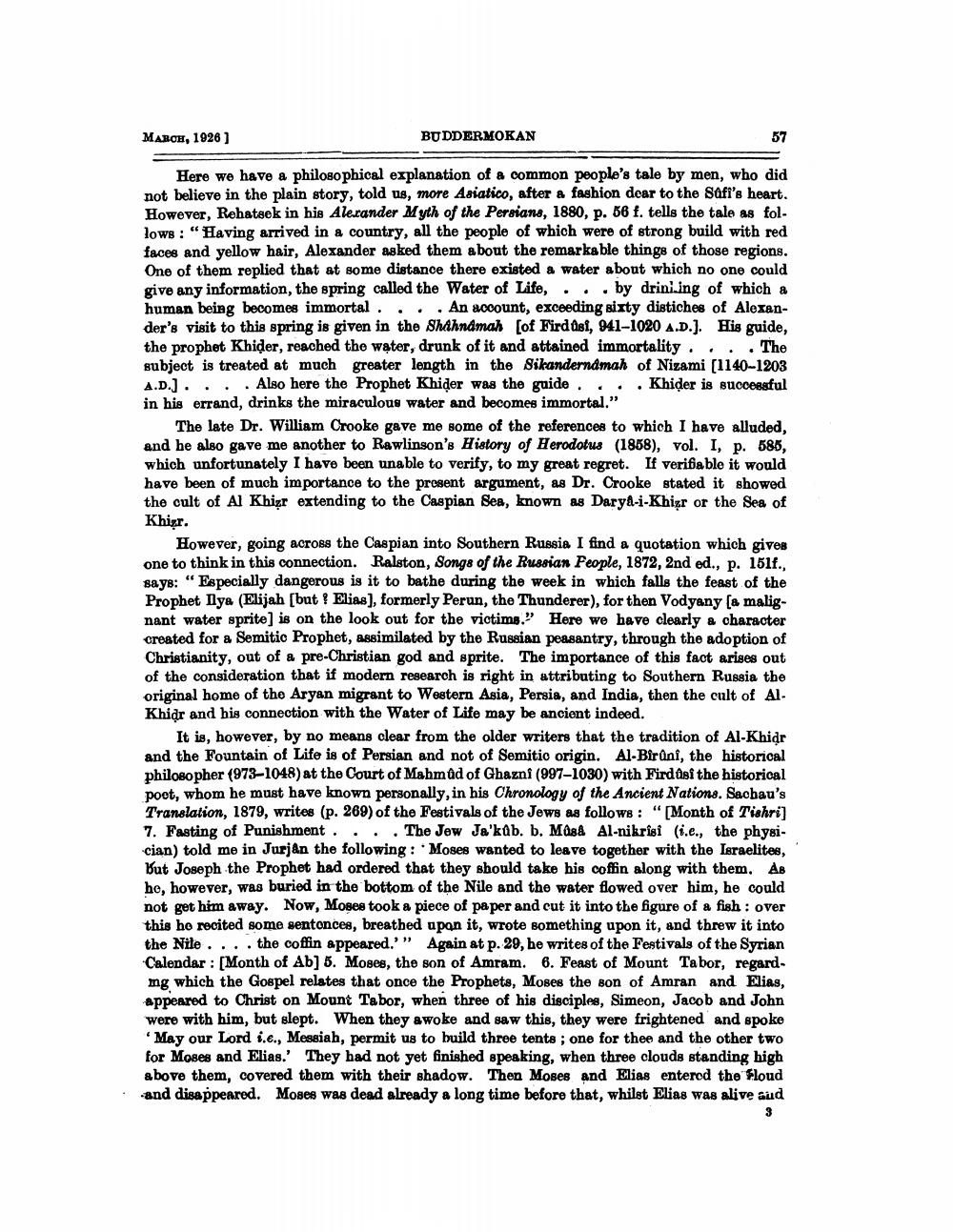________________
MARCH, 1926 1
BUDDERMOKAN
57
Here we have a philosophical explanation of a common people's tale by men, who did not believe in the plain story, told us, more Asiatico, after a fashion dear to the Safi's heart. However, Rehateek in his Alexander Myth of the Persians, 1880, p. 56 f. tells the tale as follows: "Having arrived in a country, all the people of which were of strong build with red faces and yellow hair, Alexander asked them about the remarkable things of those regions. One of them replied that at some distance there existed a water about which no one could give any information, the spring called the Water of Life,... by drini.ing of which a human being becomes immortal. ... An account, exceeding sixty distiches of Alexander's visit to this spring is given in the Shahnamah (of Fird Asi, 941-1020 A.D.). His guide, the prophet Khider, reached the water, drunk of it and attained immortality. ... The subject is treated at much greater length in the Sikanderndmah of Nizami (1140-1203 A.D.). ...Also here the Prophet Khider was the guide . . . . Khider is sucoessful in his errand, drinks the miraculous water and becomes immortal.”
The late Dr. William Crooke gave me some of the references to which I have alluded, and be also gave me another to Rawlinson's History of Herodotus (1858), vol. I, p. 585. which unfortunately I have been unable to verify, to my great regret. If verifable it would have been of much importance to the present argument, as Dr. Crooke stated it showed the cult of Al Khiţr extending to the Caspian Sea, known as Darya-i-Khișr or the Sea of Khizr.
However, going across the Caspian into Southern Russia I find a quotation which gives one to think in this connection. Ralston, Songs of the Russian People, 1872, 2nd ed., p. 151f. says: "Especially dangerous is it to bathe during the week in which falls the feast of the Prophet Ilye (Elijah [but ! Elias), formerly Perun, the Thunderer), for then Vodyany [& malignant water sprite) is on the look out for the victims." Here we have clearly a character created for a Semitio Prophet, assimilated by the Russian peasantry, through the adoption of Christianity, out of a pre-Christian god and sprite. The importance of this fact arises out of the consideration that if modern research is right in attributing to Southern Russia the original home of the Aryan migrant to Western Asia, Persia, and India, then the cult of AlKhidr and his connection with the Water of Life may be ancient indeed.
It is, however, by no means clear from the older writers that the tradition of Al-Khidr and the Fountain of Life is of Persian and not of Semitic origin. Al-Biruni, the historical philosopher (973-1048) at the Court of Mahmûd of Ghazni (997-1030) with Firdasi the historical poet, whom he must have known personally, in his Chronology of the Ancient Nations. Sachau's Translation, 1879, writes (p. 269) of the Festivals of the Jews as follows: "[Month of Tishri] 7. Fasting of Punishment. ..The Jew Ja'kub. b. Mas& Al-nikrisi (i.e., the physician) told me in Jurjan the following: Moses wanted to leave together with the Israelites, But Joseph the Prophet had ordered that they should take his coffin along with them. As ho, however, was buried in the bottom of the Nile and the water flowed over him, he could not get him away. Now, Moses took a piece of paper and cut it into the figure of a fish: over this ho recited some sentonces, breathed upon it, wrote something upon it, and threw it into the Nile. ... the coffin appeared.'” Again at p. 29, he writes of the Festivals of the Syrian Calendar : Month of Ab] 5. Moses, the son of Amram. 6. Feast of Mount Tabor, regard ng which the Gospel relates that once the Prophets, Moses the son of Amran and Elias. appeared to Christ on Mount Tabor, when three of his disciples, Simeon, Jacob and John were with him, but slept. When they awoke and saw this, they were frightened and spoke 'May our Lord i.e., Messiah, permit us to build three tents; one for thee and the other two for Moses and Elias.' They had not yet finished speaking, when three clouds standing high above them, covered them with their shadow. Then Moses and Elias entered the floud -and disappeared. Moses was dead already a long time before that, whilst Elias was alive and




